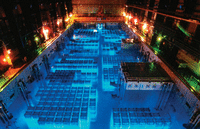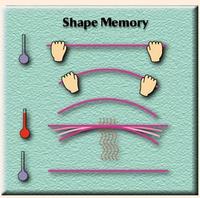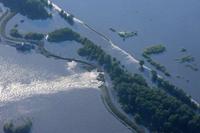-
Japan considers referendum to end nuclear power
Lawmakers in Osaka, Japan are currently mulling over whether to abandon nuclear power all together following the catastrophic nuclear accident at the Fukushima Daiichi atomic energy plant
-
-
Study: No direct link between fracking, groundwater contamination
Hydraulic fracturing (fracking) involves the high-pressure injection of water, sand and chemicals into a shale seam, which causes the rock to shatter, releasing natural gas; preliminary findings from a study on the use of hydraulic fracturing in shale gas development suggest no direct link to reports of groundwater contamination
-
-
Nuclear waste recycling for better nuclear power generation

Researchers aim to produce safe nuclear fuel that can be 80 percent recycled, compared to the current 1 percent; these fourth generation nuclear power systems can lead to a reduction of the amount of high-level, long-lived nuclear waste to a tenth of what it is today, while energy output can increase hundredfold
-
-
Groundwaterin some parts of U.S. susceptible to radium contamination
A recent U.S. Geological Survey (USGS) study found that groundwater in aquifers on the East Coast and in the Central United States has the highest risk of contamination from radium, a naturally occurring radioactive element and known carcinogen
-
-
Lawmakers blast DHS for problems with chemical facility security program
At a recent Congressional hearing, lawmakers blasted DHS officials for their failure to follow through with a program designed to secure chemical facilities in the United States
-
-
Invisibility cloak to protect buildings from earthquakes
Scientists show that by cloaking components of structures with pressurized rubber, powerful waves such as those produced by an earthquake would not “see” the building — they would simply pass around the structure and thus prevent serious damage or destruction
-
-
Advances in the use of photocatalysts to help keep water clean safe
Photocatalysis involves the acceleration of chemical reactions using the power of light; researchers experiment with different types of photocatalysts to reduce nitrates in water
-
-
Preventing earthquake-induced soil liquefaction to protect buildings
When earthquakes occur, buildings can shift or fall; often, the failure is because of soil liquefaction, a phenomenon that occurs when loose, water-saturated soils lose strength in response to the sudden shaking from an earthquake, causing the soil to behave like a liquid; scientists have come up with a way to minimize liquefaction
-
-
Shape-memory alloys for earthquake-resistant structures

To improve the performance of structures during earthquakes, researchers have been investigating the use of “smart” materials, such as shape-memory alloys, which can bounce back after experiencing large loads
-
-
Nuclear accidents pose “essentially zero risk" to public health
A new study by the U.S. Nuclear Regulatory Commission (NRC) concluded that there is only a “very small” risk to public health if a severe nuclear accident were to occur in the United States
-
-
A solution for troubled ITER nuclear fusion reactor
Nuclear fusion offers the promise of endless energy supply – but the technology requires extremely high temperatures of up to 150 million degrees in order to form plasma (ionized gas); since no material can withstand these temperatures, the fuel (a mixture of two isotopes of hydrogen: deuterium and tritium) must be kept trapped in extremely energetic magnetic fields; the magnets that produce these fields are composed of giant coils of superconducting cables; so far, the superconducting cables designed for the European ITER fusion reactor have been unable to withstand the planned 40,000 to 60,000 charge cycles
-
-
Local officials oppose “unacceptable” levee ratings

In recent years as part of an effort to bolster the nation’s flood protection infrastructure, the Army Corps of Engineers has analyzed and declared more than 200 levee systems across the country as “unacceptable,” resulting in a firestorm of criticism from local officials
-
-
Bill would allow DHS to impose cybersecurity standards
A bill before Congress would significantly increase the power of DHS to monitor the cybersecurity practices of industries and services which are part of the U.S. critical infrastructure
-
-
The cost of bolstering U.S. infrastructure cyber-protection
To achieve security capable of stopping 95 percent of cyber attacks on U.S. critical infrastructure – 100 percent protection is not attainable – experts said the industries involved would have to boost spending to a group total of $46.6 billion from the current $5.3 billion
-
-
Compressed natural gas as transportation fuel
A number of different fuel sources — ethanol, biodiesel, electricity, and hydrogen — have each shown their promise as an alternative to petroleum; scientists at Argonne Lab want to add one more contender to the list of possible energy sources for light-duty cars and trucks: compressed natural gas (CNG)
-
More headlines
The long view
Helping Strengthen America’s Critical Infrastructure
Everyday life depends on a robust infrastructure network that provides access to running water, communications technology and electricity, among other basic necessities. The experts who keep our national infrastructure secure and resilient also need a strong network to share their knowledge and train the next generation of professionals capable of solving complex infrastructure challenges.
AI and the Future of the U.S. Electric Grid
Despite its age, the U.S. electric grid remains one of the great workhorses of modern life. Whether it can maintain that performance over the next few years may determine how well the U.S. competes in an AI-driven world.
Using Liquid Air for Grid-Scale Energy Storage
New research finds liquid air energy storage could be the lowest-cost option for ensuring a continuous power supply on a future grid dominated by carbon-free but intermittent sources of electricity.
Enhanced Geothermal Systems: A Promising Source of Round-the-Clock Energy
With its capacity to provide 24/7 power, many are warming up to the prospect of geothermal energy. Scientists are currently working to advance human-made reservoirs in Earth’s deep subsurface to stimulate the activity that exists within natural geothermal systems.
Experts Discuss Geothermal Potential
Geothermal energy harnesses the heat from within Earth—the term comes from the Greek words geo (earth) and therme (heat). It is an energy source that has the potential to power all our energy needs for billions of years.
